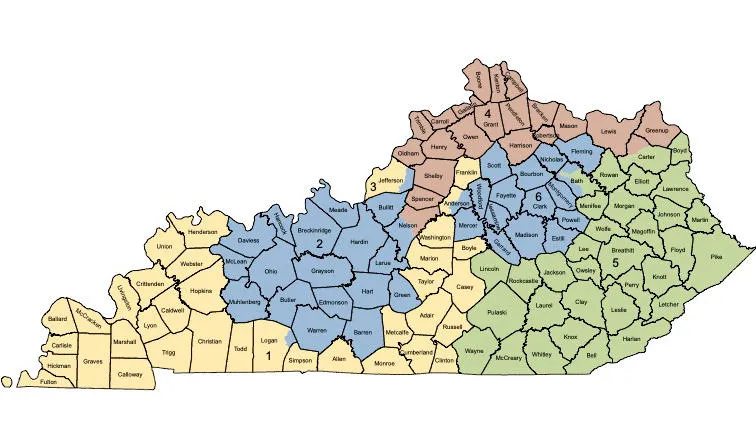What’s wrong with this picture of Kentucky’s Congressional Districts, adopted by the State Legislature this year? The answer is partisan gerrymandering, which is bad redistricting. The districts are neither cohesive nor reflective of regional interests. Even worse, they undermine the power of individuals and communities to influence their representatives.
In the First Congressional District for example, the residents of Franklin County in Central Kentucky will be represented by the same congressman as the people of Western Kentucky, extending to the Mississippi River. Not only are the residents geographically diverse, their economies, cultures, and community needs differ widely. One can only assume that the First District was drawn this way to take Frankfort out of the Sixth District so that it would be more solidly Republican, thus protecting the incumbent Republican Sixth District representative. It also accommodates the first district congressman, who lives in Frankfort.
It should be noted that Republicans are not the only bad actors. When Democrats were in control, they drew a crazy First District to accommodate their political objectives. While Kentucky’s constitution gives the legislature the power to redraw the maps every 10 years after the census, the League of Women Voters hoped that this year legislators would choose good government instead of the same old gerrymandering for political power.
Unfortunately, the redistricting maps passed by the legislature this year, including the State House and Senate maps, abound with examples of partisan gerrymandering. In the Kentucky House of Representatives’ map, some counties were sliced and diced, for none other than partisan and incumbent reasons. Laurel County was divided so that it shares districts with ten other counties, Pulaski shares districts with nine other counties, and Pike shares districts with seven other counties. The same unnecessary divisions also occurred in many cities across the state.
Throughout the redistricting process there were frequent pleas to legislators from the League of Women Voters and many others, asking for public input. The pleas fell on deaf ears.
During recent legislative sessions, we urged passage of bills calling for an advisory commission that would hold public hearings and offer maps, leaving final decisions to legislators. A resolution was filed simply asking for an open and transparent process with opportunities for citizen comment. All were rejected, and in January Kentuckians got the same old results – maps drawn behind closed doors and passed within days of introduction without public debate or input.
--30--
Written by Fran Wagner, President, League of Women Voters of Kentucky.
Comments







